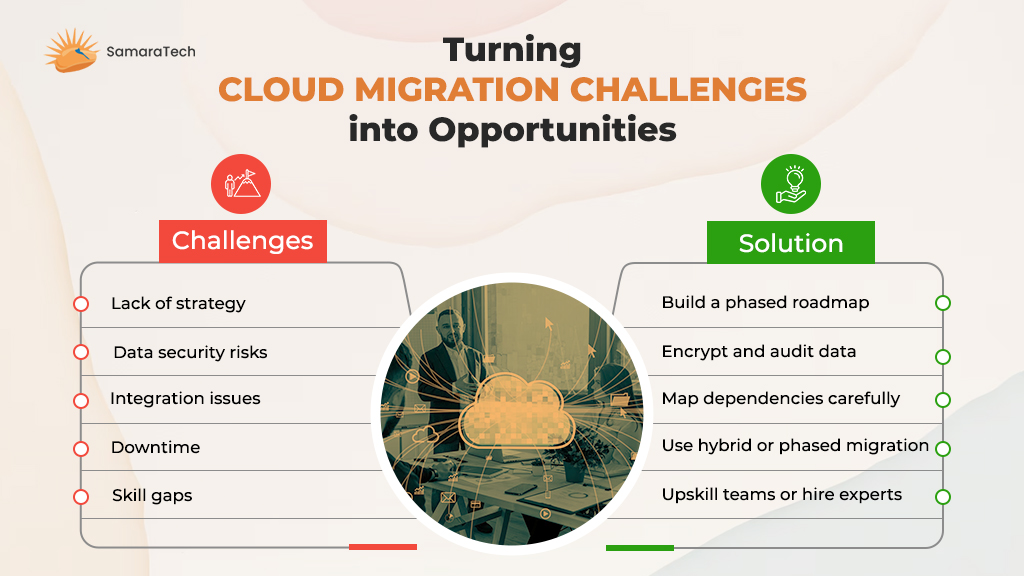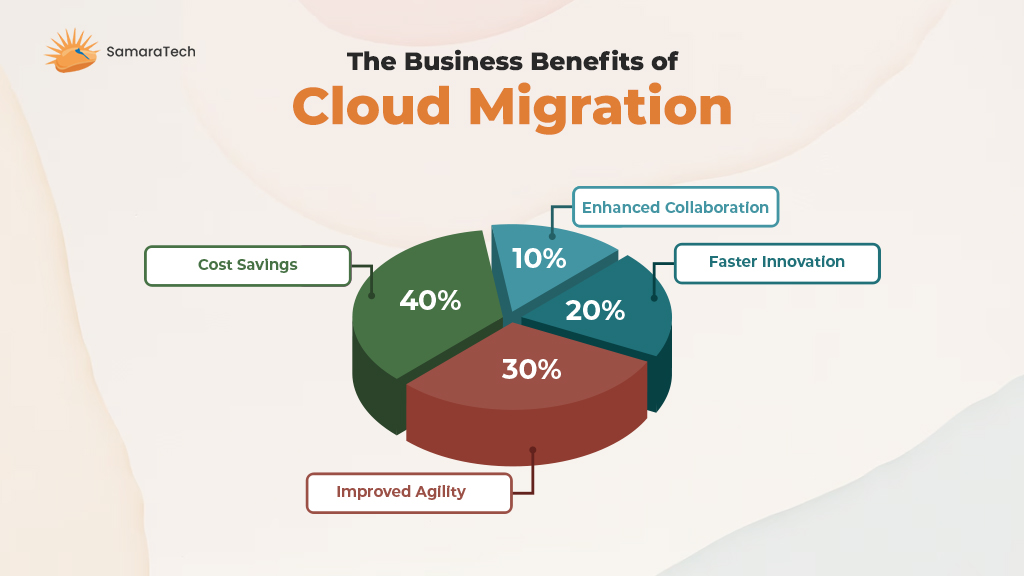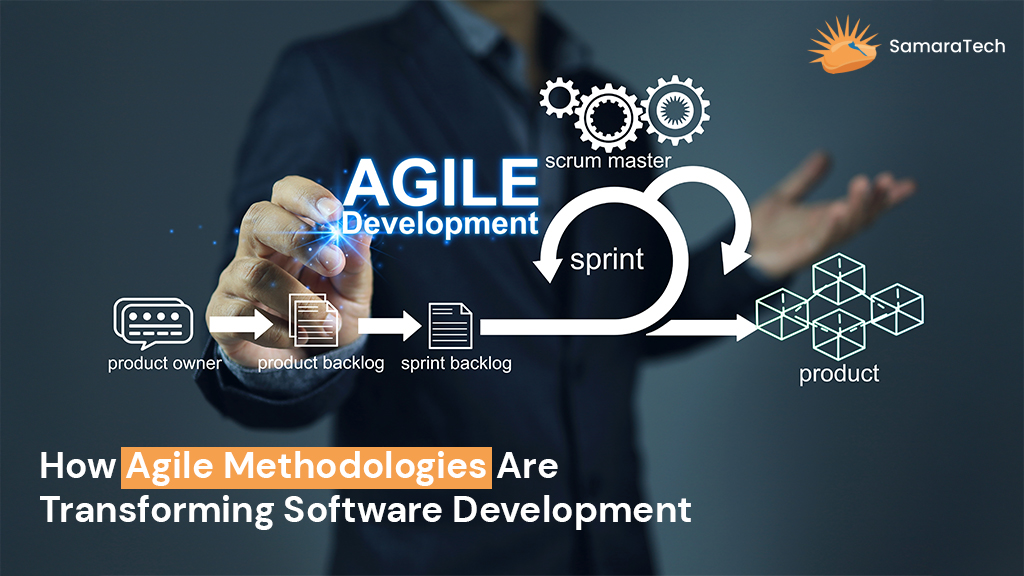With 93% of enterprises embracing a multi-cloud strategy, the journey to the cloud has become inevitable. Yet, cloud migration is not just moving data to the cloud. From strategic missteps to integration woes, the cloud migration process can be overwhelming. However, with the right cloud migration strategies, you can unlock unprecedented agility, scalability, and cost efficiency.
Here are some actionable solutions to overcome cloud migration challenges and guide your enterprise through a seamless transition.
Why Cloud migration is worth the effort
With the right cloud migration strategies, you can navigate the journey confidently and reap long-term rewards. While challenges exist, the benefits of enterprise cloud migration far outweigh the difficulties. Here’s why the effort is worthwhile:
- Cost Efficiency – Reduced operational expenses and scalable resources.
- Improved Agility – Adapt quickly to evolving market demands.
- Innovation – Unlock new capabilities with advanced cloud technologies.
How to turn cloud migration challenges into opportunities

1. Develop a clear cloud migration strategy
Don’t you plan long before going for a vacation? Similarly, starting your cloud migration journey without a solid strategy is like setting sail without a map. Many organizations dive into cloud adoption without fully understanding their requirements, leading to cost overruns and operational inefficiencies. A clear cloud migration strategy aligns your business goals with the migration process, helping you avoid unnecessary disruptions.
Here’s how to develop a winning strategy:
- Assess your current IT infrastructure – Identify which systems, applications, and workloads are ready for migration and which require upgrades.
- Set clear objectives – Define specific goals like cost reduction, improved performance, or enhanced security.
- Choose the right cloud model – Decide between public, private, hybrid, or multi-cloud based on your business needs.
- Involve stakeholders early – Engage cross-functional teams to ensure alignment across departments.
- Create a detailed roadmap – Break down the migration into manageable phases with timelines and milestones.
2. Mitigate data security and compliance risks
Data security remains a top concern for businesses migrating to the cloud. Misconfigurations, breaches, and compliance violations can have far-reaching consequences. Enterprises often find themselves unprepared to meet the stringent compliance standards associated with cloud environments.
Here’s how you can mitigate security and compliance challenges:
- Implement robust security protocols – Use encryption for data in transit and at rest.
- Choose compliant cloud providers – Opt for providers that adhere to industry-specific regulations like GDPR or HIPAA.
- Adopt zero-trust policies – Restrict access based on strict identity verification.
- Regularly audit your cloud environment – Use automated tools to identify vulnerabilities and compliance gaps.
- Train your team – Ensure your IT staff understands security best practices for the cloud.
3. Ensure integration with existing IT infrastructure
One of the biggest cloud migration challenges is integrating cloud systems with legacy IT infrastructure. Without proper planning, businesses face compatibility issues, increased downtime, and inefficiencies in the migration process.
You can ensure seamless integration with the following measures:
- Conduct a thorough assessment – Map out dependencies between legacy systems and cloud environments.
- Leverage middleware tools – Use tools that bridge gaps between on-premises and cloud systems.
- Adopt a hybrid approach – Gradually move workloads while maintaining essential on-premises systems.
- Perform pilot tests – Test integrations in smaller environments before scaling up.
- Partner with experts – Collaborate with cloud migration consultants for guidance.
4. Avert downtime and operational disruptions
Downtime is not just inconvenient; it can be costly. Every minute of downtime during migration can disrupt business operations, affect customer experience, and lead to revenue loss. Planning is key to minimizing these disruptions.
Here’s how to avoid prolonged downtime:
- Plan for phased migration – Move workloads incrementally instead of all at once.
- Utilize redundancy – Set up backup systems to ensure business continuity.
- Schedule during off-peak hours – Choose times when disruptions will have the least impact.
- Monitor migration in real-time – Use monitoring tools to identify and resolve issues quickly.
- Create a recovery plan – Be prepared with a rollback strategy in case of unforeseen problems.
5. Bridge the skill gaps in the workforce
The rapid pace of cloud technology evolution often leaves IT teams struggling to keep up. A lack of cloud expertise can delay migrations, increase costs, and result in misconfigurations.
You can bridge the skill gap with these strategies:
- Invest in training – Upskill your team with certifications in cloud platforms like Oracle Cloud Infrastructure or AWS.
- Hire cloud experts – Bring in experienced professionals to lead the migration.
- Leverage managed services – Outsource to providers offering specialized cloud migration solutions.
- Encourage cross-training – Create opportunities for team members to learn from one another.
- Utilize automation tools – Simplify HR operations, assembly line processes, and others with tools like SaaS Solutions, and Energy Monitoring Systems (EMS) that reduce manual intervention.
By addressing these challenges with proactive cloud migration solutions, businesses can ensure a smoother transition and maximize the benefits of cloud adoption.

Cloud migration best practices
While overcoming cloud migration challenges is crucial, you can ensure long-term success by following industry best practices. These tried-and-tested methods can save you time and resources during the cloud migration process:
- Conduct a pre-migration assessment – Evaluate workloads and dependencies to determine migration readiness.
- Choose the right cloud provider – Compare providers based on scalability, pricing, and support.
- Optimize workloads – Re-architect applications to make the most of cloud-native features.
- Prioritize security – Implement multi-factor authentication and regular security audits.
- Adopt continuous monitoring – Use analytics to measure performance and identify issues post-migration.
Leveraging Oracle Cloud Infrastructure for seamless migration
Cloud migration is a strategic shift that determines how businesses operate and innovate. It involves migrating applications, services, and workloads from on-premises or legacy systems to cloud platforms like Oracle Cloud Infrastructure.
When it comes to cloud migration solutions, Oracle Cloud Infrastructure (OCI) stands out as a reliable partner, offering unparalleled scalability, security, and performance to meet the needs of modern enterprises.
- Advanced Security – End-to-end encryption and compliance tools.
- High Performance – Superior compute power for demanding workloads.
- Cost Efficiency – Flexible pricing models tailored to your usage.
OCI simplifies the cloud migration process, enabling businesses to achieve their goals with minimal friction.
Conclusion
The path to the cloud may have its twists and turns, but with a clear roadmap, robust security measures, and a trusted partner like SamaraTech, you can overcome any challenge. By embracing the cloud migration best practices outlined here, your business can transition seamlessly while unlocking its full potential.
Make it effortless with SamaraTech
At SamaraTech, we specialize in delivering tailored cloud migration solutions that empower businesses to achieve digital transformation seamlessly. From strategy to execution, we’re here to ensure a smooth and successful migration process. Our services encompass strategy development, security optimization, and IT infrastructure integration. With expertise in Oracle Cloud Infrastructure, SamaraTech ensures your enterprise’s migration journey is efficient, secure, and aligned with your goals. Partner with us to turn cloud adoption challenges into growth opportunities.
Ready to take the next step? Let SamaraTech’s expertise in cloud migration solutions guide your journey.
Let’s build a smarter, more connected future together! Connect Now!




